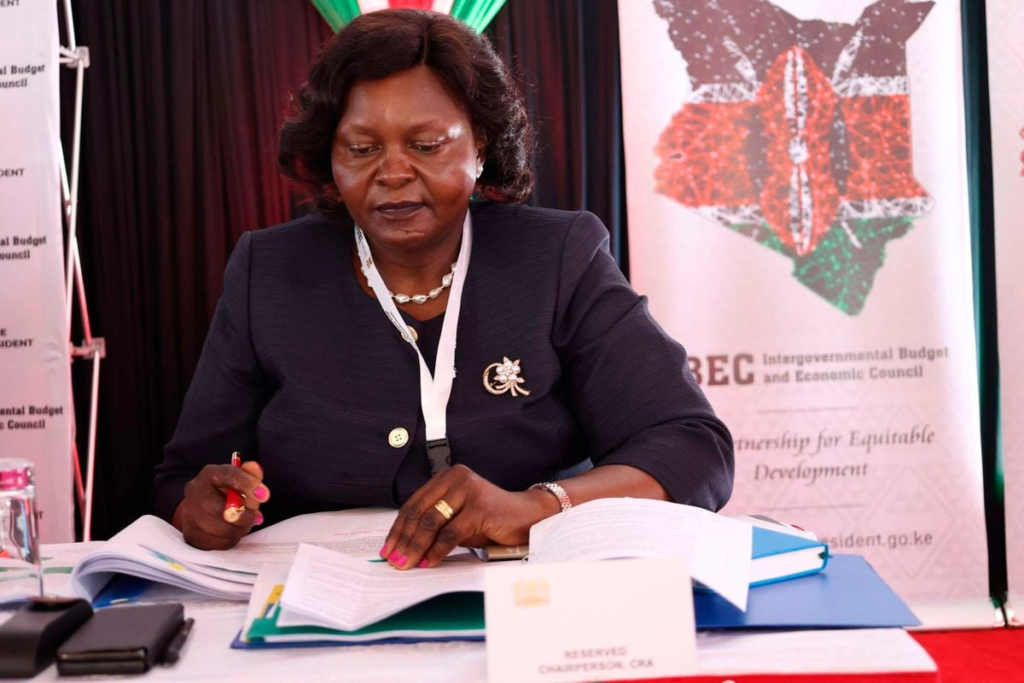
What It Means for Development
Kenya’s devolved system of government seeks to address regional inequalities by redistributing national revenue to its 47 counties. The cornerstone of this effort is the equitable revenue sharing plan guided by the Commission on Revenue Allocation (CRA). Recently, the CRA proposed a revised revenue sharing formula that has sparked debate across political and economic circles.
The revised formula aims to enhance equity but introduces significant changes to how counties are funded. While some counties stand to gain financially, others may lose substantial revenue, raising concerns about its implications on development, service delivery, and regional equity.
Overview of the Proposed Revenue Sharing Plan
The CRA’s mandate involves developing frameworks to distribute national revenue among counties. The new proposal, set to be implemented in the 2025/2026 financial year, is the fourth basis for revenue sharing since devolution began in 2013.
The formula comprises six parameters with weighted percentages:
- Population (33%): Accounts for the size of a county’s population, reflecting demand for services.
- Basic Share (26%): A fixed allocation to cover administrative costs.
- Poverty Level (23%): Directs funds to poorer counties to alleviate disparities.
- Land Area (10%): Considers the cost of service delivery across large areas.
- Road Network (4%): Allocates resources for road maintenance and development.
- Fiscal Responsibility (4%): Rewards prudent financial management.
This revised approach shifts emphasis from population to poverty levels and land area, a change that significantly alters revenue allocations among counties.
Counties Set to Gain (Winners)
The proposed formula primarily benefits counties with vast land areas and high poverty levels. Here are the key winners:
- Marsabit County
- Allocation increase: Approximately Ksh 2 billion
- Reason: Large land area and developmental challenges
- Turkana County
- Allocation increase: Ksh 1.3 billion
- Reason: Vast geographical size and high poverty index
- Garissa County
- Allocation increase: Ksh 950 million
- Reason: Infrastructure needs and economic disparity
- Bomet County
- Allocation increase: Ksh 661 million
- Reason: Higher consideration for fiscal responsibility
- Taita Taveta County
- Allocation increase: Ksh 429 million
- Reason: Expansive land area and poor road network
These counties can now invest in critical sectors such as healthcare, infrastructure, and education to address long-standing inequalities.
Counties Set to Lose (Losers)
Counties with dense populations but smaller land sizes face potential revenue cuts. Key losers include:
- Mandera County
- Allocation reduction: Ksh 2.19 billion
- Reason: Reduced emphasis on population as a parameter
- Kakamega County
- Allocation reduction: Ksh 1.3 billion
- Reason: Limited weight on population
- Nairobi County
- Allocation reduction: Ksh 688 million
- Reason: Urban infrastructure funding disparities
- Kilifi County
- Allocation reduction: Ksh 1.1 billion
- Reason: Shift in priorities to land area and poverty levels
- Meru County
- Allocation reduction: Ksh 751 million
- Reason: Budget constraints from reduced allocations
These reductions may limit service delivery, stall ongoing projects, and strain county budgets.
Stakeholder Reactions
The proposed formula has elicited mixed reactions:
- County Governors
Governors from adversely affected counties argue the formula undermines their ability to sustain projects and deliver services. - National Treasury
The Treasury has welcomed the changes, citing a balanced approach that promotes fairness and development. - Civil Society
Advocacy groups emphasize the need for a formula that promotes inclusivity without penalizing densely populated counties.
Impact on Development
Positive Impacts for Marginalized Counties
Counties gaining revenue can expand healthcare access, invest in road infrastructure, and promote economic development in underserved areas.
Challenges for Urban Counties
Reduced funding may affect urban counties’ ability to sustain infrastructure and essential services, potentially exacerbating inequality.
Economic Considerations
The proposed revenue sharing formula reflects Kenya’s broader economic objectives:
- Promoting Equity: Targeting underdeveloped regions with higher poverty indices.
- Encouraging Fiscal Responsibility: Rewarding efficient financial management.
- Balancing Development: Addressing disparities without disproportionately disadvantaging populous counties.
Recommendations for a Balanced Formula
To ensure inclusivity and equitable development:
- Hybrid Approach: Incorporate additional parameters such as urban infrastructure needs.
- Transition Period: Gradually implement changes to allow counties to adjust.
- Stakeholder Engagement: Include input from county leaders and civil society.
- Transparent Monitoring: Ensure accountability in fund utilization.
Also Read: Directline Assurance Customers Face Ksh 5 Billion Exposure
Kenya’s proposed county revenue sharing plan is a bold step toward addressing inequalities in resource allocation. While it offers opportunities for marginalized counties, it also poses challenges for urban centers and populous regions. Balancing these competing needs will require collaboration, compromise, and a commitment to fairness.
The formula’s success depends on ensuring it promotes equitable development without jeopardizing service delivery. Counties, stakeholders, and citizens must work together to shape a revenue sharing framework that reflects Kenya’s diverse needs and aspirations.

FAQs:
What is the proposed county revenue sharing plan in Kenya?
The proposed county revenue sharing plan is a new formula developed by the Commission on Revenue Allocation (CRA) to guide the distribution of national revenue among Kenya’s 47 counties. The formula uses six parameters to allocate funds: population, poverty levels, land area, road network, fiscal responsibility, and basic share. The goal is to ensure equitable distribution, particularly favoring counties with larger populations, higher poverty rates, and greater land areas.
Why was the revenue sharing formula revised?
The revision of the revenue sharing formula was aimed at addressing regional inequalities and ensuring that counties with the highest need for development—such as those with large land areas and significant poverty rates—receive more financial support. The changes were made in response to ongoing concerns about the fairness and sustainability of previous allocations, with an emphasis on equity and development.
Which counties are expected to benefit the most from the new formula?
Counties with vast land areas and high poverty levels are expected to benefit significantly from the new formula. Key beneficiaries include counties like Marsabit, Turkana, Garissa, and Bomet, which will see substantial increases in their allocations due to their geographical and socio-economic challenges.
Which counties are set to lose funding under the new plan?
Counties with dense populations but smaller land areas are set to lose funding under the proposed plan. These include counties like Mandera, Kakamega, Nairobi, Kilifi, and Meru. The reductions primarily stem from the shift in emphasis from population to factors such as land area and poverty levels, which may disadvantage highly populated urban counties.
What is the rationale behind the changes in the revenue sharing formula?
The main rationale behind the changes is to promote equity, address disparities between counties, and ensure that counties with higher poverty rates and larger land areas receive more support. The formula also rewards fiscal responsibility, incentivizing counties to manage their resources efficiently. The goal is to create a more balanced and fair distribution of funds across the country.
How will the new formula impact service delivery in counties?
The new formula will likely improve service delivery in counties that are receiving more funds, especially those in need of basic infrastructure, healthcare, and education services. For counties that lose revenue, however, service delivery could be compromised, leading to potential delays in ongoing projects and a strain on local resources. This could exacerbate existing inequalities between counties.
How does the new formula affect counties with large urban populations like Nairobi?
Urban counties like Nairobi are set to face reductions in their allocations under the new formula. This is because the formula places less emphasis on population size as a key parameter. As a result, these counties may struggle to maintain urban infrastructure and provide quality services to their residents without adequate funding from the national government.
What are the financial implications of the proposed plan for Kenya’s national budget?
The proposed county revenue sharing plan has significant financial implications for Kenya’s national budget. The redistribution of funds will shift resources from wealthier, more populous counties to those with more urgent development needs. This could lead to more equitable growth, but it may also create challenges for counties that are losing revenue. The government will need to ensure that the overall national budget can support these shifts without compromising other national priorities.
How will the government ensure the new formula is implemented fairly?
To ensure fairness in the implementation of the new formula, the government must establish clear guidelines for fund allocation and monitoring. This includes transparent tracking of how funds are used by county governments and ongoing assessments of whether the formula is achieving its equity goals. Regular stakeholder consultations will also be necessary to address concerns and make adjustments where necessary.
What role do counties play in the implementation of the revenue sharing plan?
Counties are expected to manage the funds they receive effectively and ensure they are used to improve public services and infrastructure. Local governments will need to demonstrate fiscal responsibility and make strategic investments to ensure that their communities benefit from the financial resources allocated to them. The county governments will also be tasked with ensuring that the needs of their populations are met within the constraints of their budgets.
How will this new formula affect the long-term development goals of Kenya?
In the long term, the proposed revenue sharing formula could help Kenya achieve more balanced and inclusive development across its counties. By prioritizing poverty alleviation and addressing the unique challenges of large, underdeveloped counties, the formula may contribute to reducing regional inequalities. However, the effectiveness of the formula will depend on how well counties manage their resources and implement projects that promote sustainable growth.
Will the new revenue sharing formula remain permanent?
The revenue sharing formula is not necessarily permanent. It is subject to periodic reviews by the Commission on Revenue Allocation (CRA) and other stakeholders to ensure that it remains relevant to the evolving economic and developmental needs of the counties. Adjustments may be made to the formula in future cycles based on the outcomes of its implementation and changes in the national economy.
How can counties ensure they receive a fair share of the national revenue?
Counties can ensure they receive a fair share of national revenue by demonstrating fiscal responsibility and focusing on equitable development. Counties that manage their resources effectively, deliver key services, and address pressing challenges like poverty and infrastructure gaps are more likely to benefit from future revenue allocations. Engaging in transparent budgeting and spending processes can also strengthen a county’s case for receiving more funds.
What should Kenya do to improve the formula further?
To improve the formula further, Kenya could consider incorporating additional parameters, such as urban infrastructure needs, economic output, and the cost of living in urban centers. A hybrid approach that accounts for both poverty and urbanization could strike a better balance between rural and urban needs. Additionally, ensuring a gradual implementation phase will allow counties to adjust to the changes without disrupting ongoing projects or services.
How will this revenue sharing plan influence economic growth in Kenya?
By focusing on equitable distribution, the proposed revenue sharing plan has the potential to stimulate economic growth in historically underserved areas. Increased funding for infrastructure projects, healthcare, education, and other key services can create more opportunities for economic development and job creation in these regions. As a result, the plan may help reduce disparities in economic opportunities and improve the overall economic health of the nation.





